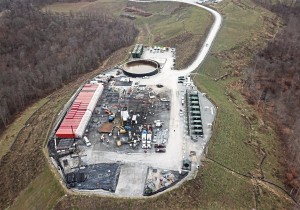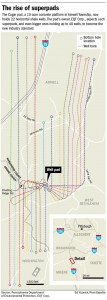From an Article by ANYA LITVAK, Pittsburgh Post-Gazette, January 15, 2018
Dave Elkin remembers in the earlier days of the Marcellus when EQT drilled three wells from a single well pad and it was considered a technological marvel. “The greatest thing since sliced bread,” Mr. Elkin, a senior vice president of asset optimization at EQT Corp., thought at the time.
It was a quaint memory that contrasts sharply with the company’s and industry’s new normal: superpads — concrete platforms that can house 30 wells, maybe even 40, with long horizontal tentacles stretching underground for up to 4 miles in each direction.
A superpad means a quarter of a billion dollars pumped into a single hillside in a place like rural Washington County. It means fewer well pads in total but much more activity on those that exist. It means that from a 10-acre spot, a company like EQT can theoretically slurp natural gas from underneath an area nearly the size of the City of Pittsburgh.
“I call them mini-industrial complexes,” said David Schlosser, president of exploration and production at EQT. Downtown-based EQT — now the largest producer of natural gas in the U.S. — is leading the Marcellus pack in supersizing its well pads, with about a dozen sites permitted to hold 20 or more wells.
There’s the Big Sky pad in Nottingham, Washington County, with 26 permitted wells. The Strope pad in Franklin Township, Greene County, with 28. The Prentice pad in Forward Township has 37 wells permitted on it.
They may not all materialize, Mr. Schlosser cautioned; the company often gets permits for more wells than it will eventually drill to keep its options open.
The Cogar pad in Amwell Township is a case in point. It was permitted to hold 30 wells, but to date only 22 have been drilled, and EQT says it is stopping there. The pad itself is on a hill and it’s difficult to see all the machinery on the concrete slab from the winding country roads that encircle it.
Yet everything around it hints at the operation. Pipeline ditches, trucks, lights, road signs intended to guide the trucks away from vulnerable roads — all are preludes to the industry on the hill.
Rise of Superpads (Ed Yozwick/Post-Gazette)
Cogar is one of the EQT’s largest pads to date. The company averages about 17 or 18 wells on a well pad.
Supersizing the wells — drilling more wells per pad and extending those wells farther underground — was a key motivator for EQT’s $6.7 billion acquisition of Canonsburg-based Rice Energy Inc. last year. The consolidation is a sign that the shale game is maturing.
Oil and gas companies across the country’s shale regions are negotiating the optimum size of a pad — one that marries the efficiencies of having one site of operations with the careful choreography of spacing the production from each well so it doesn’t overwhelm the gathering and compression infrastructure.
Denver-based Antero Resources, which drills in the Marcellus and Utica in West Virginia and Ohio, said it is averaging about 10 wells pads in the Marcellus. “That’s way up from three wells or four wells per pad just a few years ago for most operators,” Glen Warren, the company’s president, said during an earnings call in September.
Range Resources’ president and CEO, Jeff Ventura, explained in an analyst call in September 2016 that the company has been building well pads big enough to accommodate 20 wells for years. But in order to “spread a fixed amount of capital out” and make sure that the leases for those sites are secured through some level of natural gas production, Range has ended up with a bunch of pads with five or fewer wells on them.
“Looking forward, it becomes a wind in our sails,” he said. Not only can Range save on road and infrastructure construction by returning to those pads to drill more wells, Mr. Ventura said, but it can react to market trends quicker by having pads at the ready.
For example, if natural gas liquids prices tick up, Range can return crews to well pads in liquids-rich areas. If they fall, it can shift to well pads in dry gas areas. Last year, about a third of Range’s new drilling activity came from pads that had already been drilled in prior years, a company spokesman said.
In the Permian Basin in Texas, Encana has built a “mega pad” that is slated to hold 64 wells. It has been described as spanning the length of eight football fields and the width of two and is, by the company’s account, a very busy site with multiple rigs operating in tandem.
More than half of the wells on the “mega pad” have already been drilled, and the Canadian company is targeting rock formations at several different depths.
The same is happening in the Marcellus and Utica shales.
EQT’s largest pads — “upwards of 40 wells” — Mr. Schlosser said, will be the ones with both Marcellus and Upper Devonian wells on them. The company believes the two layers of gas-rich shale should be developed together to prevent cracks between the two from draining valuable gas.
In Greene County and further south, where EQT is likely to target only one shale layer, the company will probably average close to 20 wells per pad, he said. Squeezing even that many on a single site requires some creative geometry in the subsurface.
Instead of drilling all of the wells straight down to what is called a kickoff point and then curving the pipe horizontally at the end, EQT is starting the kickoff process for some wells at shallower depths and taking its time with that curve before reaching the final destination. This ensures that the wells don’t crowd each other underground.
In a cross section of the earth, this kind of well would look less like an upright chair and more like a recliner. For neighbors of such sites, the superpad trend means the oil and gas company will be visiting more often and staying longer.
If it takes a company about a year to drill and complete a well pad with a handful of wells, developing one with 15 or 20 is at least a three-year commitment, Mr. Schlosser explained, because EQT drills the wells in batches. “We split them out in runs of five or six at a time,” he said.
Otherwise, the pipelines that collect the gas would need to be huge and would quickly become obsolete since shale gas volumes drop off significantly in the first year. The same goes for water hauling infrastructure.
So drillers will finish the first batch, let the gas flow, wait for it to taper and then start on the next half a dozen to fill the pipes back up.
As for the length of the horizontal wells, Mr. Elkin said the current “economic and technological limit” is 21,000 feet, or 4 miles. In the Utica Shale, which is deeper than the Marcellus, horizontal wells may stretch some 25,000 feet.
But that’s just for today. Considering that in 2009, a Chesapeake Energy brochure proudly announced an eight-well “superpad” in the Haynesville Shale, all limits are subject to rapid change.



{ 1 comment… read it below or add one }
“For neighbors of such sites, the superpad trend means the oil and gas company will be visiting more often and staying longer.”
Nice wording, huh? As long as you understand that these friendly visits come with guns drawn if you decide you DON’T want a “visit”–most friendly visits depend on the willingness of the one visited, if not an advance invitation.
These “visits” do tremendous damage to the land and water and air, and extract minerals whose value can be guessed by the fact that one wellpad consumes a quarter billion dollar investment. When was the last time you had a visitor who could have you arrested for trespassing on your own land if you tried to decline the visit?
This is not a visit, this is an invasion, from which our governments from local to national will not protect us. We matter here just as much as the chipmunks and other fauna with whom we share the land. If it were necessary to get rid of all of us to get at the oil and gas and send it to where they want, we’d be cleared out in a heartbeat with no protest from officials at any level.
But it isn’t necessary–they can just give us a pittance for the section of our land directly under the wellpad, and some of us will self deport to places we hope won’t be like this … most will stay and watch as our quality of life and the place we’ve chosen to live get degraded more and more, until there’s nothing left to extract.
Mary Wildfire, Roane County, WV